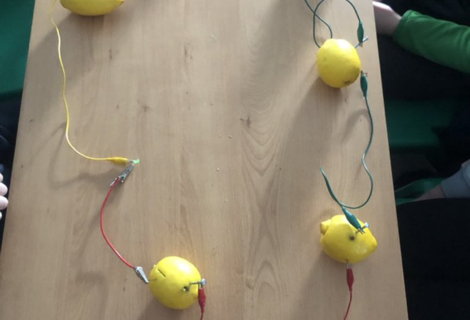STEM Show & Tell
6th Class 'Energy and Forces- Electricity - 'Making a Battery'
20 March 2022 | Discover Primary Science, Stem at Home
In preparation for the ESB Science Blast, the children are continuing to investigate our question 'How does electricity work?'.
We decided to make a battery using lemons, zinc coated ( galvanised) nails and copper coins/ copper wire. We stuck the nail and copper coin into the lemon. We connected a wire from each the nail and the copper coin and connected it to a light bulb. The zinc and copper are called electrodes, and the lemon juice is our electrolyte.
All batteries have a “+” (known as the cathode) and a “-” (known as the anode) terminal. In our lemon battery, the copper plate is our positive cathode and the zinc plate the negative anode.
Our result: the Bulb didn't work initially. We tried connecting more lemons, one at a time, until all 6 of our 'lemon batteries' were connected to the light bulb. Again, the bulb didn't light.
We decided that maybe the nails may not be galvanised, so we replaced them with new galvanised nails. This was not the issue. We replaced the copper coins with purer copper wire and again this was not the issue. We then replaced the bulb with an LED light, Finally it lit up!
Conclusion: Electric current is created by the flow of atomic particles called electrons. Conductors are materials that allow electrons (and the electrical current) to flow through them. Elec6trons flow from the negative to the positive terminal. So in our experiment electrons are flowing from our zinc plate, through the lemon juice to the copper plate. From there it goes into our alligator clip, along the wire, into the zinc plate on the next lemon, where it picks up more energy as it travels through that battery. It continues on, building energy with each additional cell we add. Until finally we have enough voltage to power a light bulb. We also conclude that LED batteries need much less energy to work than a regular candescent bulbs so are more sustainable.


